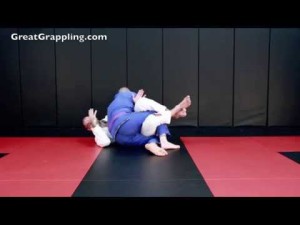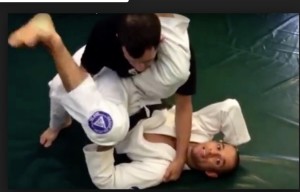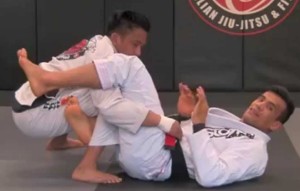Shaolin sweep / back roll sweep from half guard
The Shaolin sweep was made famous by Vitor ‘Shaolin’ Ribeiro.
In its classical form, it starts from knee-shield half guard, aka, Z-guard or 93 guard. It’s a great alternative for situations where you can’t play the common underhook half guard game for whatever reason.
I would approach it like this: Whenever you have your knee shield guard and you feel that trying for the underhook is a bad idea, cross grab the sleeve and attempt something like a scissor sweep, back and to the side of the sleeve you’re grabbing.
See 2:15 of this clip:
Mendes Bros ‘bottom 393 knee shield back roll sweep’
If the opponent doesn’t want to get scissor-swept, then they have to push back in towards you. That’s when you have the momentum to perform the Shaolin sweep in the opposite direction. So we’re setting up a double attack: if they don’t want to get scissor swept, they have to drive towards you and to one side. If they don’t want to get Shaolin swept, they have to drop their weight back and to the other side. The defense for one sets up the other.
This sweep is also great to use in a situation where you’re in a reverse scarf hold style half guard, like this:

You can use essentially the same move, but you don’t have the double attack because the scissor sweep isn’t there. In this case, you need to focus more on pulling your knees to your chest to off balance the opponent to your north direction. See the James Foster clip below for an example of this.
More Shaolin sweep clips:
Here is Shaolin himself demonstrating it (‘Shaolin teaches the ‘Shaolin Sweep’ from Half Guard’):
‘Shaolin sweep half guard’ by Bruno Dias:
‘Half guard back roll sweep’ by Gerry Young:
‘The Roll Over Sweep from Half Guard with James Foster’
‘Amanda Loewen back roll sweep from half guard’
https://www.facebook.com/AmandaLoewenSBG/videos/687099881367830/
‘roll over shoulder sweep from half guard’ by Carnage BJJ
‘Yuri Simoes Belt Grip Backroll Sweep from Half Guard | BJJ LIBRARY’

